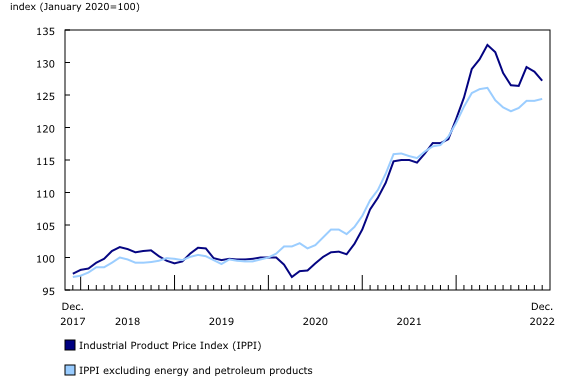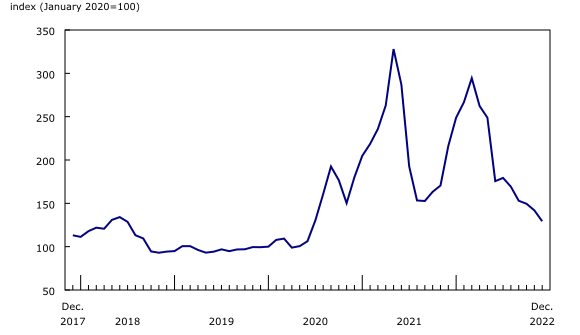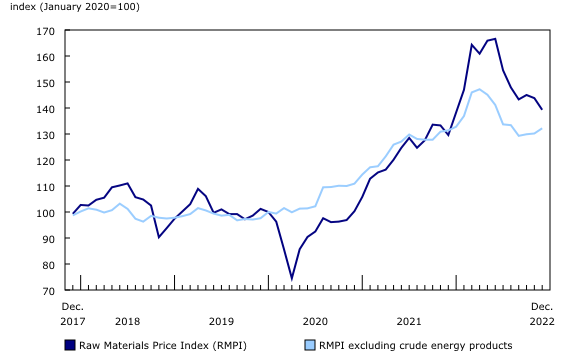Industrial product and raw materials price indexes, December 2022
Released: 2023-01-18
Industrial Product Price Index
In December, the Industrial Product Price Index (IPPI) declined 1.1% month over month and was up 7.6% year over year. Prices for energy and petroleum products (-9.8%) fell for a second consecutive month in December, leading the monthly decrease in the IPPI. Compared with December 2021, prices were up 31.8%. Lower prices for finished motor gasoline (-14.6%) and diesel fuel (-8.7%) were mainly responsible for the monthly decline in this group. These decreases were partially influenced by lower prices for crude oil, which fell partially on macroeconomic concerns as well as global production slightly in excess of demand. Diesel prices remained relatively higher than gasoline prices, partially due to the effects of the Russian invasion of Ukraine. Russia was a major supplier of diesel to Europe, which increased its imports from other sources.
Prices for softwood lumber (-8.9%) posted a fifth consecutive monthly decline in December 2022. On a yearly basis, prices were down 40.2% in December, the largest year-over-year drop on record since the start of the series in January 1956. The decline was mainly due to a slowing residential housing market in the US, which coincided with rising interest rates in the country. In December 2022, the US Federal Reserve announced a 50-basis point interest rate hike, elevating the federal funds rate to its highest level since December 2007. The National Association of Home Builders/Wells Fargo Housing Market Index showed that US home builder confidence fell for a 12th consecutive month in December 2022.
Prices for primary ferrous metal products fell 2.1% month over month in December. On a yearly basis, the group posted a record decline of 16.2%. Lower prices for basic and semi-finished iron or steel products (-2.2%) were mainly responsible for the price decrease in this group. Steel prices continued to decline in December on weakening global demand and COVID-19 lockdowns in China.
Prices for intermediate food products declined 2.9% month over month in December and were up 11.8% year over year. The monthly decline was mainly on lower prices for grain and oilseed products, not elsewhere classified (-5.9%), the largest monthly drop since June 2021 (-7.7%). This group contains vegetable oils, including soybean oil and canola oil, which are relatively substitutable in terms of their use, so price changes in one product can affect the others. Soybean oil prices in particular fell sharply in response to regulations in the US. On December 1, 2022, the US Environmental Protection Agency announced biodiesel production targets for 2023 through 2025 that were lower than market expectations. The US production targets are mandated and therefore induce demand for biodiesel and its primary feedstock, soybean oil.
Prices for primary non-ferrous metal products rose 7.3% month over month in December 2022, a third consecutive monthly increase. Compared with December 2021, prices were 7.8% higher. Prices rose for precious metals including unwrought silver and silver alloys (+12.1%) and unwrought gold and gold alloys (+5.1%). These gains were partially attributable to a weaker US dollar in December 2022, as well as lower yields on US 10-year treasury notes. Prices for unwrought nickel and nickel alloys rose 14.5%. Within the month of December, nickel prices were volatile, as liquidity and volumes were low at the London Metal Exchange.
Raw Materials Price Index
The Raw Materials Price Index (RMPI) fell 3.1% on a monthly basis in December and increased 7.5% year over year.
Lower prices for crude energy products (-9.3%) were mainly responsible for the monthly decrease in RMPI. Year over year, prices were 19.9% higher compared with December 2021. The price of conventional crude oil fell 10.5% month over month in December, bringing the price of crude close to the level in January 2022, prior to Russia's invasion of Ukraine. A slight excess of global production over demand, as well as bearish economic sentiment, were partly behind the price drop. Excluding crude energy products, the RMPI increased 1.5%.
In December, prices for metal ores, concentrates and scrap increased 5.4% month over month and 2.1% year over year, led by higher prices for gold, silver, and platinum group metal ores and concentrates (+5.7%). In spite of negative economic sentiment, the price of iron ores and concentrates rose by 21.0% in December, partly on speculation. In January 2023, China's state planner announced that it would be ramping up efforts to stop speculation in the iron ore market.
Industrial Product Price Index: 2022 Annual Review
The Industrial Product Price Index (IPPI) measures price changes for outputs of the Canadian manufacturing industry. Just as the Consumer Price Index measures inflation of prices for consumer purchases, the IPPI measures inflation for manufacturers' selling prices.
Inflation was the main economic topic in 2022. Retrospectively, what does the IPPI tell us about producer price inflation in 2022 compared with previous years? One way to analyze prices is to look at the average price level for each year in the IPPI series, which goes back all the way to 1956. From 2021 to 2022, the annual IPPI increased by 12.9%.
Looking at a longer timeline, the price of goods sold by manufacturers operating in Canada was 9.5 times higher in 2022 than in 1956. While much of this price inflation happened gradually over the previous 65 years, the previous two years have shown unprecedented growth.
The 12.9% increase in the IPPI in 2022 was the fifth largest gain on record since the series began in 1956.
High prices for crude oil were a dominant factor in all five largest gains on record for the annual IPPI. In 1973/1974, following an embargo by Organization of Petroleum Exporting Countries (OPEC), oil prices quadrupled in what is now known as the first oil crisis. In 1979, the world saw the second oil crisis, as lower production from Iran prompted another price shock.
Crude oil prices affect the IPPI directly, as crude is the main input to refined petroleum products (including gasoline and diesel), and these products carry a large weight within the index. There are also secondary effects from other products derived from crude oil or petroleum, such as chemicals, plastics and fertilizers. Furthermore, as energy is used for industrial production as well as transportation, it can affect the costs for many products.
In 2022, the price of energy and petroleum products measured by the IPPI rose by 53.3% (correction), following a 42.8% increase in 2021 and a 27.5% decrease in 2020. Why did energy prices rise so much? Global oil prices fell sharply in 2020 due to the COVID-19 pandemic reducing demand. In response to low prices, producers reduced supply, including production cuts by OPEC+. As global economies reopened with fiscal and monetary stimulus, demand recovered faster than overall supply. Global consumption was in excess of production for most months from July 2020 to January 2022. Furthermore, in 2022, Russia's invasion of Ukraine created uncertainty about supply and prices, as Russia is the world's third biggest oil producer.
Excluding energy and petroleum products, prices of products sold by manufacturers in Canada were up 8.4% in 2022, the second highest increase on record since the inception of that category in 1980, surpassed by 2021 (+11.5%).
Prices for food products made by manufacturers in Canada rose in 2022. Prices for intermediate food products increased 21.2%, and this group includes cooking oils, such as canola oil, which is a staple Canadian product. Strong demand underpinned these increases, while the Russian invasion of Ukraine also played a role in driving up costs for food producers. The conflict blocked exports of grains from Ukraine and drove up prices for natural gas, as Russia is a large energy exporter. Natural gas is used in the production of fertilizers and as such the price of ammonia and chemical fertilizers was up 50.3% (correction) in 2022. Animal feed (+16.4%) (correction) also rose. Together, these price pressures contributed to higher prices for fruit, vegetables, feed and other food products (+14.4%), as well as meat, fish and dairy products (+3.6%).
Prices for both ferrous and non-ferrous metals increased in 2022. The most notable metal story in 2022 was the roller coaster market for nickel. On March 8, the London Metal Exchange (LME) price of nickel briefly surpassed $100,000 USD per megaton. For reference, the price was typically in the range of $10,000 to $20,000 for the previous 10 years. The exceptional increase was caused by a short squeeze, a situation in which traders betting that the price of nickel would decline are forced to purchase the asset (known as 'covering' a short) if their bet fails and the price increases instead. These forced purchases induce demand and further push the price up, which makes more shorts cover and, in turn, the price can continue rising. The LME suspended nickel trading that day for the first time in 30 years, and eventually even cancelled transactions from March 8. Prices for basic and semi-finished iron or steel products rose 5.6% (correction) in 2022, as Chinese production fell by 2.2% in 2022 compared with the previous year, according to the China Iron and Steel Association. Production throughout the year was curbed intentionally intermittently to reduce emissions, amid a slowing property market and sporadic COVID-19 lockdowns.
Elevated input costs together with supply chain challenges, contributed to higher prices for metal building and construction materials (+17.9%) and for fabricated metal products (+21.3%).
As US and Canadian interest rates rose in 2022 in response to inflation, the US housing market cooled and, in turn, reduced demand for softwood lumber. When looking at the annual IPPI (which looks at the average price within a given year), softwood lumber prices were down by 6.5% (correction) in 2022, after gaining 60.3% in 2021 and 38.6% in 2020. However, within the year, there was substantial movement, and by December 2022, softwood lumber prices fell to levels last seen in June 2020.
Note to readers
The Industrial Product Price Index (IPPI) and the Raw Materials Price Index (RMPI) are available at the Canadian level only. Selected commodity groups within the IPPI are also available by region.
With each release, data for the previous six months may have been revised. The indexes are not seasonally adjusted.
The IPPI reflects the prices that producers in Canada receive as goods leave the plant gate. The IPPI does not reflect what the consumer pays. Unlike the Consumer Price Index, the IPPI excludes indirect taxes and all costs that occur between the time a good leaves the plant and the time the final user takes possession of the good. This includes transportation, wholesale and retail costs.
Canadian producers export many goods. Canadian producers often indicate goods' prices in foreign currencies, especially in US dollars, which are then converted into Canadian dollars. This is particularly the case for motor vehicles, pulp and paper products, and wood products. Therefore, fluctuations in the value of the Canadian dollar against its US counterpart affect the IPPI. However, the conversion to Canadian dollars reflects only how respondents provide their prices. This is not a measure that takes into account the full effect of exchange rates.
The conversion of prices received in US dollars is based on the average monthly exchange rate established by the Bank of Canada and available in Table 33-10-0163-01 (series v111666275). Monthly and annual variations in the exchange rate, as described in the release, are calculated according to the indirect quotation of the exchange rate (for example, CAN$1 = US$X).
The RMPI reflects the prices paid by Canadian manufacturers for key raw materials. Many of those prices are set on the world market. However, as few prices are denominated in foreign currencies, their conversion into Canadian dollars has only a minor effect on the calculation of the RMPI.
Products
Statistics Canada launched the Producer Price Indexes Portal as part of a suite of portals for prices and price indexes. This webpage provides Canadians with a single point of access to a variety of statistics, and measures related to producer prices.
The video "Producer price indexes" is available on the Statistics Canada Training Institute webpage. It introduces Statistics Canada's producer price indexes—what they are, how they are made, and what they are used for.
Addition of a new table and additional data
Effective February 28, 2022, table 18-10-0272-01 has been added to the Statistics Canada website featuring regional indexes for select refined petroleum products. In addition, tables 18-10-0266-01 and 18-10-0268-01 now contain data for select 6- and 7-digit North American Product Classification System series.
Next release
The industrial product and raw materials price indexes for January 2023 will be released on February 17.
Correction notice
Effective February 21, 2023, annual movements for the following series were corrected within the 2022 Annual Review text above: energy and petroleum products, ammonia and chemical fertilizers, animal feed, basic and semi-finished iron or steel products, and softwood lumber.
Contact information
For more information, or to enquire about the concepts, methods or data quality of this release, contact us (toll-free 1-800-263-1136; 514-283-8300; infostats@statcan.gc.ca) or Media Relations (statcan.mediahotline-ligneinfomedias.statcan@statcan.gc.ca).
- Date modified:





